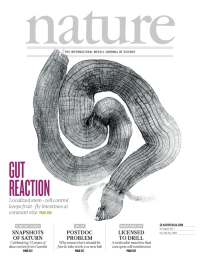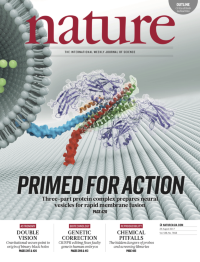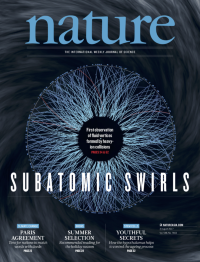Volume 548
-
No. 7669 31 August 2017
Most adult organs are in a constant state of renewal, with old cells continually being replaced by the progeny of stem cells. For organs to keep the same size, there must be strict equilibrium between cell production and cell loss, but how such control is exercised is unclear. In this issue, Lucy Erin OâBrien and her colleagues reveal that tissue-level equilibrium, and thus constant organ size, result from localized communication between cells during renewal. Investigating the intestine of the fruit fly Drosophila (pictured on the cover), OâBrien and her team uncovered a feedback mechanism in which the deaths of old enterocytes release a block on stem-cell division. In healthy enterocytes, the protein E-cadherin prevents the secretion of epidermal growth factors (EGFs) by suppressing the EGF-activating protease rhomboid. When an enterocyte undergoes its natural death, loss of E-cadherin triggers induction of rhomboid, which in turn activates EGF receptors on nearby stem cells, sparking replacement of the dying cell. By limiting cell replacement to the time and place of tissue need, this mechanism ensures tissue-level equilibrium. Cover image: Lucy Erin OâBrien and Jackson Liang
-
No. 7668 24 August 2017
Rapid triggering of neurotransmitter release by action potentials requires that synaptic vesicles are primed for fast fusion with the presynaptic membrane, but the molecular basis of vesicle priming has been unclear. An interaction between the SNARE complex and the protein synaptotagmin-1 has already been identified as part of the process. In this weekâs issue, Axel Brunger and colleagues complete the picture with crystal structures of a primed pre-fusion complex consisting of the SNARE complex (green, red and blue) and the protein complexin (yellow) and a second synaptotagmin-1 molecule (violet). This complex includes a newly revealed tripartite SNAREâcomplexinâsynaptotagmin-1 interface that primes and locks the complex ready for action. Action-potential-driven calcium ions bind to the two synaptotagmin-1 proteins to unlock the complex and trigger membrane fusion on a sub-millisecond timescale. Cover image: Eric Smith, Jeremy Leitz and Qiangjun Zhou
-
No. 7667 17 August 2017
The cover image shows a conceptualized view of an individual with multiple cancers that have spread from their primary site, or metastasized. The primary cancers represented include prostate cancer (blue), breast cancer (pink), lung cancer (green) and colon cancer (orange). In this issue, Arul Chinnaiyan and colleagues report sequences of the DNA and RNA of 500 diverse human metastatic cancers as part of the Michigan Oncology Sequencing Program. The researchers characterize the landscape of genomic alterations in the cancers, including some mutations in germline DNA. They also show that clinical RNA sequencing can be used to characterize gene fusions, transcriptional signatures and the immune microenvironment of metastatic cancer. Cover image: Ella Marushchenko and Elina Karimullina (Ella Maru Studio, Inc.)
-
No. 7666 10 August 2017
The number of pollinators is in decline around the world. Multiple factors have been identified as contributing to this fall, including agricultural intensification and invasive alien species. Artificial light at night has also been suggested as a problem for nocturnal pollinators such as the elephant hawk-moth (Deilephila elpenor) shown on the cover. In this issue, Eva Knop and her colleagues test this idea in a field experiment in Switzerland. They exposed ruderal meadows to artificial light at night, and monitored nocturnal and diurnal plantâpollinator interactions and the resulting pollination service. Pollinator visits to plants fell by 62% in the illuminated plots, and fruit set of a focal plant fell by 13%. They also found that the structure of combined diurnal and nocturnal networks meant that the negative consequences of disrupted nocturnal pollination could negatively affect daytime pollinator communities as well. The findings suggest that artificial light at night, which is spreading at an estimated rate of 6% per year, poses yet another threat to pollinators and the service they provide. Cover image: Malcolm Schuyl/Alamy
-
No. 7665 3 August 2017
The cover image shows the tracks formed as the result of a collision between two gold nuclei in the STAR experiment at the Relativistic Heavy Ion Collider at Brookhaven National Laboratory in New York. When such heavy ions collide, they form exotic states of matter that are fluid in nature. If the two particles hit non-centrally, this fluid is predicted to have vortices. In this weekâs issue, the STAR Collaboration reports experimental observation of such vortices for the first time. The team reveals that the quarkâgluon plasma that results from the collision has the highest vorticity ever observed. This work could offer fresh insight into the forces that bind quarks inside a proton. Cover image: courtesy of Alex Schmah





